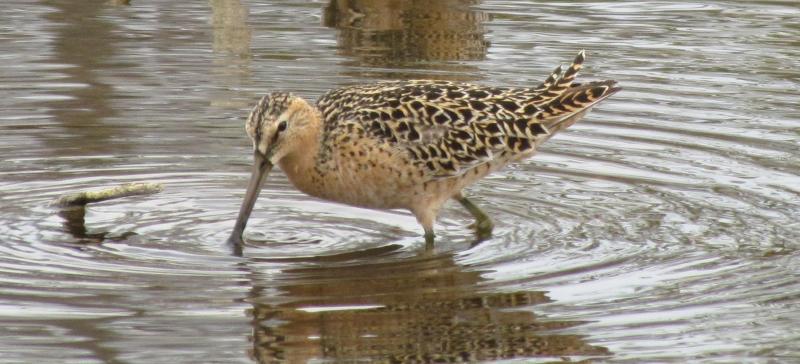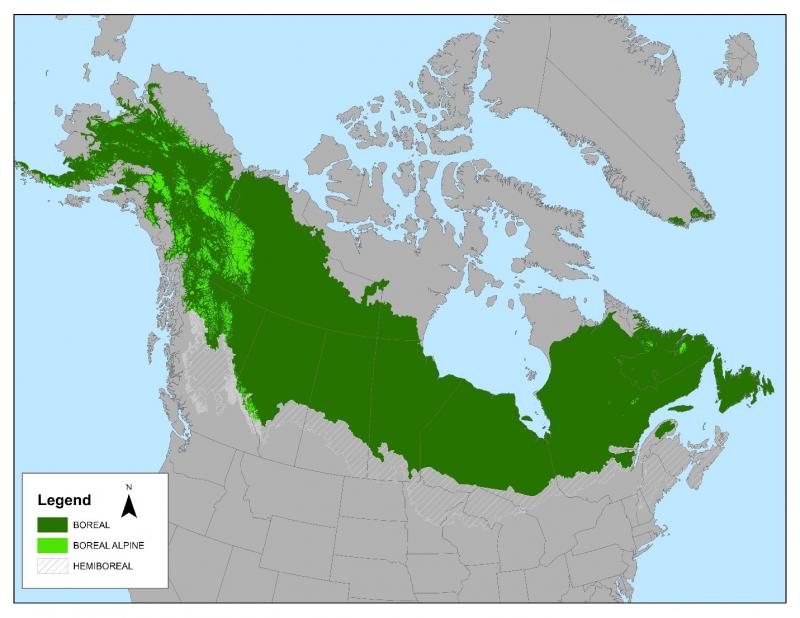A Last Chance for Large Scale Conservation?
For those of us who live parts of the world that have a long history of human impacts to the land, it may be hard to imagine that there are still a few parts of the world where the land has not experienced such impacts. One of the most important of these regions for us here in Maine is the vast area to our north called the Boreal Forest biome.
Modern geographers have delineated the boundaries of the Boreal Forest biome as extending from interior Alaska eastward between the Arctic and the Prairies, and then between the Great Lakes and Hudson Bay across Ontario through Quebec and reaching the shores of the Atlantic in Newfoundland and Labrador. Some versions of the map place the Gaspe Peninsula of Quebec as the southeastern extreme of the Boreal Forest biome and the closest part of the region to us here in Maine. Incidentally, this is also the last home of woodland caribou south of the St. Lawrence River, a species that inhabited Maine until the early 1900s.
The Boreal Forest biome is vast—1.5 billion acres in size, dotted with millions of lakes and ponds, including some of the largest in the world, and the longest undammed rivers left in North America. The world’s second-largest peatland, stretching over 900,000 acres, is found in the Boreal Forest, and the area is thought to have more surface freshwater and wetlands than just about anywhere else on earth. The biome is estimated to support within in its lands, at least 500 billion trees. These trees and all of the habitats that they are part of in the Boreal make it an incredible place for all sorts of amazing wildlife.
For us here in Maine, the most visible of this wildlife are the 3-5 billion birds that, at the end of the summer nesting season, begin spilling south across the border on their way to wintering grounds in the U.S., Mexico, the Caribbean, and Central and South America. Here in Maine the first of those Boreal Forest breeding birds begin arriving in early July with the arrival of shorebirds like short-billed dowitchers and the lesser yellowlegs that. By late August and September, the numbers passing through become immense—warblers, flycatchers, swallows, sparrows, and more shorebirds.
A new scientific paper published last week describes these and many other of the amazing features and globally significant conservation values of the Boreal Forest. Truth be told, one of us (Jeff) was proud to be among the list of authors of the paper, entitled “The State of Conservation in North America’s Boreal Forest: Issues and Opportunities” and is publicly accessible for all to see (https://www.frontiersin.org/articles/10.3389/ffgc.2020.00090/full) through a journal called “Frontiers in Forests and Global Change.”
One of the features that make the Boreal Forest biome so special is the fact that, as the paper describes, less than 20% of its 1.5 billion-acre area has been subjected to the large-scale impacts of industrial forestry, mining, oil and gas extraction, large hydro, agricultural conversion, and other factors. The 300 million acres of the biome that have been impacted are largely concentrated in its southern edges that are most accessible to roads and other infrastructure. Still, more than 1.2 billion acres of the Boreal Forest biome remains ecologically intact. That means that it is one of the last opportunities, in the course of human history on this planet, to protect as much habitat as science tells us we need to protect in order to maintain the birds and other wildlife and plants, and the ability of the forest to clean the air and water.
The paper goes on to describe the amazing work being led by Indigenous governments and communities across the Boreal Forest biome to carry out the largest land conservation actions in modern history. Their efforts have resulted in tens of millions of acres of newly protected habitat over the last 15 years, areas that together provide nesting habitat for tens of millions of the migratory birds that we so love to see as they pass through Maine each spring and fall.
Indigenous governments and leaders are not done with their work; there are dozens of new areas being proposed for protection every year, and new land stewardship initiatives called Indigenous Guardians programs blossoming across the Boreal Forest biome. They deserve our thanks and our continued support as they ensure our birds will forever have homes to return to each summer to raise their young.
Jeffrey V. Wells, Ph.D., is a Fellow of the Cornell Lab of Ornithology and Vice President of Boreal Conservation for National Audubon. Dr. Wells is one of the nation's leading bird experts and conservation biologists and author of “Birder’s Conservation Handbook”. His grandfather, the late John Chase, was a columnist for the Boothbay Register for many years. Allison Childs Wells, formerly of the Cornell Lab of Ornithology, is a senior director at the Natural Resources Council of Maine, a nonprofit membership organization working statewide to protect the nature of Maine. Both are widely published natural history writers and are the authors of the book, “Maine’s Favorite Birds” and “Birds of Aruba, Bonaire, and Curaçao: A Site and Field Guide” from Cornell Press.
Event Date
Address
United States





























